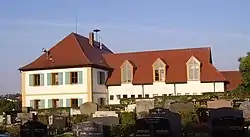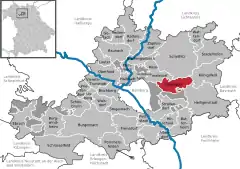Litzendorf
Litzendorf is a community in the Upper Franconian district of Bamberg. Owing to administrative reform it has been a unified community since 1 May 1978.
Litzendorf | |
|---|---|
 Town hall | |
 Coat of arms | |
Location of Litzendorf within Bamberg district  | |
 Litzendorf  Litzendorf | |
| Coordinates: 49°54′N 11°0′E | |
| Country | Germany |
| State | Bavaria |
| Admin. region | Oberfranken |
| District | Bamberg |
| Subdivisions | 8 Ortsteile |
| Government | |
| • Mayor (2020–26) | Wolfgang Möhrlein[1] (CSU) |
| Area | |
| • Total | 25.85 km2 (9.98 sq mi) |
| Elevation | 311 m (1,020 ft) |
| Population (2022-12-31)[2] | |
| • Total | 6,220 |
| • Density | 240/km2 (620/sq mi) |
| Time zone | UTC+01:00 (CET) |
| • Summer (DST) | UTC+02:00 (CEST) |
| Postal codes | 96123 |
| Dialling codes | 09505 |
| Vehicle registration | BA |
| Website | www.litzendorf.de |
Geography
Litzendorf and most of its outlying centres lie in the Ellern Valley, which is surrounded by wooded heights with the Bamberg district's two highest elevations, the Geisberg (585 m) and the Stammberg (560 m).
Constituent communities
Litzendorf's namesake centre is not the biggest of its Ortsteile. Pödeldorf is somewhat bigger. The community has these centres, each given here with its own population figure:
 |
Kunigundenruh | 2 inhabitants | |
 |
 |
Litzendorf | 1,492 inhabitants |
 |
 |
Lohndorf | 385 inhabitants |
 |
Melkendorf | 757 inhabitants | |
 |
Naisa | 747 inhabitants | |
 |
Pödeldorf | 1,753 inhabitants | |
 |
Schammelsdorf | 784 inhabitants | |
 |
Tiefenellern | 210 inhabitants |
Neighbouring communities
 |
 |
 |
 |
 |
 |
| Memmelsdorf | Scheßlitz | Königsfeld | Heiligenstadt | Strullendorf | Hauptsmoorwald |
History
The derivation of the name Litzendorf is unclear. It could have come from the Slavic word lyko ("bast") or from the Germanic word litzel ("little").
In Merovingian and Carolingian times, when the villages, which were likely of Frankish and Slavic origin, arose, the Ellern Valley was still heavily wooded.
The name Litzendorf first cropped up in 1129 in a document from Bishop of Bamberg Otto, which mentions an Otgoz von Licindorf. Otgoz belonged to the lower subservient nobility and was a court and administrative official to Saint Otto.
Litzendorf later belonged to the High Monastery at Bamberg, but since the Reichsdeputationshauptschluss of 1803, the community has belonged to Bavaria.
Population development
Within municipal limits, 3,507 inhabitants were counted in 1970, 4,825 in 1987 and 5,907 in 2000. In 2005 it was 6,179, and in 2007 6,106.
Politics
In 1999, municipal tax revenue, converted to euros, amounted to €2,279,000 of which business taxes (net) amounted to €206,000.
Municipal council
The community council is made up of 21 members, listed here by party or voter community affiliation, and also with the number of seats that each holds:
| CSU | SPD | GRÜNE | Christliche Wählervereinigung | Total | |
| 2002 | 9 | 5 | 3 | 3 | 20 |
(as of election on 3 March 2002)
Coat of arms
Litzendorf's arms might heraldically be described thus: Party per pale Or and azure, Or a lion rampant sable armed and langued gules, thereover a bendlet argent, azure a helm argent with nasal dexter.
The Bamberg lion stands for the High Monastery's former overlordship in Litzendorf. The helmet stands for the ministeriales of Litzendorf, who were active in the 12th century, at a time when they bore no arms.
Sightseeing
Fränkische Straße der Skulpturen
The "Franconian Road of Sculptures" between the villages of Tiefenellern, Lohndorf and Litzendorf came into being in 1994 and is a sculpture exhibit in the middle of the Ellern Valley countryside.
Singers’ memorial near Melkendorf
The Sängerehrenmal for the dead and fallen of the Franconian Sängerbund ("Singers’ League") was built in 1963 on a plot of higher ground above Melkendorf. The memorial consists of twelve limestone columns set in a circle and an altarlike sarcophagus. In the memorial stone are memorial books with the names of the dead from the originally 12, now 13, singing circles. The wrought iron altar wing bears the Latin inscription Mortui vivimus – "We, the dead, live".
Jungfernhöhle near Tiefenellern
The Jungfernhöhle ("Maids’ Cave") near Tiefenellern is a Neolithic archaeological site. Digs here brought to light use of the cave by four cultures in the New Stone Age and by almost all subsequent ones. The name Jungfernhöhle refers to the human remains found here, which were overwhelmingly female.
Barrows near Litzendorf
On the road from Litzendorf to Geisfeld are found early Celtic barrows. The group of mounds is completely surrounded by forest. The barrows’ diameters range from 8 to 25 metres. During digs in the 19th century, material from the Bronze Age and the early Iron Age was unearthed.
Parish church of St. Wenceslas
The Baroque Pfarrkirche St. Wenzeslaus in Litzendorf was built between 1715 and 1718 by master builder Johann Dientzenhofer. It is built from shiny, gold-coloured iron-bearing sandstone blocks and can be seen far from the community.
The choice of the Bohemian duke and national Saint Wenceslas as the church's patron likely goes back to Prince-Bishop Lambrecht von Brun, who was a close adviser to Emperor Karl IV, who lived in Prague, and also chancellor to his son Wenceslas (Wenzel). After Litzendorf was raised to parish in 1406, there arose a new building whose four-storey choir tower still stands today.
When damage to the building began to show in the late 17th century, there was hesitation about repairing it. Only in 1702, after Johann Christoph Reinhard had been made the parish priest and set himself to the business at hand was something done about it. He wanted something special, and therefore he had the Bamberg court master builder Johann Dientzenhofer add a suitable nave onto the choir tower.
Gallery
 Interior of St. Wenceslaus's parish church, built 1715-1718
Interior of St. Wenceslaus's parish church, built 1715-1718 Franconian Road of Sculptures
Franconian Road of Sculptures Franconian Road of Sculptures
Franconian Road of Sculptures Nativity Scene in Lohndorf
Nativity Scene in Lohndorf Waterwheel at old mill in Pödeldorf
Waterwheel at old mill in Pödeldorf Eulenfelsen, or Owl's Crags, at the Ellerer Berg
Eulenfelsen, or Owl's Crags, at the Ellerer Berg.jpg.webp) Entrance to Jungfernhöhle
Entrance to Jungfernhöhle
References
- Liste der ersten Bürgermeister/Oberbürgermeister in kreisangehörigen Gemeinden, Bayerisches Landesamt für Statistik, 15 July 2021.
- Genesis Online-Datenbank des Bayerischen Landesamtes für Statistik Tabelle 12411-003r Fortschreibung des Bevölkerungsstandes: Gemeinden, Stichtag (Einwohnerzahlen auf Grundlage des Zensus 2011)
External links
- Official site (in German)
- View over of Litzendorf (in German)
- "Franconian Switzerland" (in German)
- Heraldic blazon (in German)
- Singers’ memorial near Melkendorf (in German)